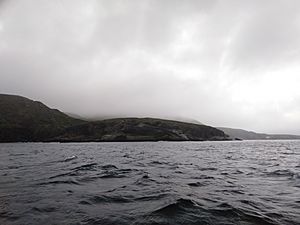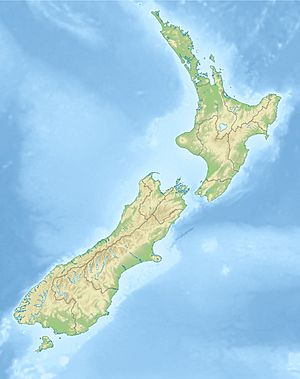South Cape / Whiore facts for kids
Quick facts for kids South Cape / Whiore |
|
|---|---|
| Māori: Ōpēhia or Whiore | |

South Cape / Whiore - The southernmost point of Stewart Island / Rakiura
|
|
| Coordinates | 47°17′24″S 167°32′16″E / 47.29000°S 167.53778°E |
| Elevation | 85 metres (279 ft) |
| Geology | Cape |
South Cape / Whiore is a special piece of land that sticks out into the sea. It marks the very southernmost point of Stewart Island / Rakiura. This also makes it the furthest south point of the main New Zealand islands.
Contents
Discovering New Zealand's Cardinal Capes
South Cape is one of four important points in New Zealand. These were named the "Cardinal Capes" by Captain James Cook. He was exploring the world on his first voyage. The other three capes are North Cape, Cape East, and West Cape.
Cook's First Map of South Cape
When Captain Cook first saw South Cape, he called it "Cape South." He made a map of the area, but it wasn't quite right. Cook thought Stewart Island was connected to the South Island. He drew a narrow strip of land where Foveaux Strait actually is. This strait is the sea channel that separates the two islands.
South Cape: One of the World's Great Capes
South Cape is also known as one of the world's five Great Capes. These are very important points for ships sailing around the world. The other Great Capes are found in South America, Africa, and Australia.
South Cape / Whiore: A Name with History
In 1998, South Cape got a new, dual name: South Cape / Whiore. This change happened because of a special law called the Ngāi Tahu Claims Settlement Act 1998. This law was part of an agreement between the New Zealand government and the Ngāi Tahu people.
Why the Name Change Happened
The Ngāi Tahu are a major Māori group, also called an iwi. They made claims against the New Zealand government. These claims were about times when the Treaty of Waitangi was not followed. The Treaty of Waitangi is a very important agreement in New Zealand's history. Adding the traditional Māori name, Whiore, to South Cape was part of making things right. It shows respect for the history and culture of the Māori people.


